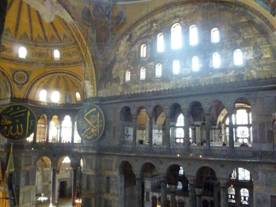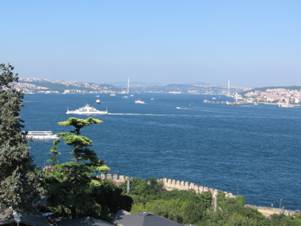

|
The organizers of ICPR 2010 made a small mistake by choosing Istanbul as their location. Read on and you’ll see why! Istanbul…. Before the start of ICPR my knowledge of this city was based on its history: it is located strategically at the Bosporus, the small strip of water separating Asia and Europe. Therefore, it became one of the most important cities in ancient Greek history under the name Byzantium, in Roman history as Constantinople, and in Osmanic times as Istanbul. This unique situation has left its traces everywhere in the city, but before I get completely off-topic I’d better refer you to Wikipedia (en.wikipedia.org/wiki/Istanbul) if you want to know more. Enough of my basic knowledge! What I didn’t know is that Istanbul is among the 5 largest cities in the world with its 12.8 million inhabitants. For someone who was raised in the Netherlands (16.6 million inhabitants) and had long-term stays in Denmark (5.5 million) and Austria (8.4 million), this is a number that is hard to grasp – well, I guess that holds for most people. This population size obviously has its impact on the infrastructure. So, when I read about the possibility to arrange an airport-hotel transfer, I thought that it would be faster, easier and definitely cheaper to get taxi. I was wrong – about the price. With such a large city it indeed takes quite some time to get somewhere. To my pleasant surprise the cab driver warned me that it would be an “expensive” trip. This was something I was not used to and found to be typical of the friendly Turkish manners that I experienced at the conference center and the hotel. Among the well-known big-city-problems are traffic jams. Also, Istanbul clearly faces the problem that the density of cars is too high. One way to solve this as a cab driver is to use every tiny opportunity to change lanes if there is just a tiny little hole that would bring you half a meter further. All drivers seemed to be rather experienced in this, as I didn’t see a single accident – to my big surprise. Among these drivers were also the bus drivers that brought us to the social events: the welcome reception and the conference dinner. At these trips they showed us their amazing skills, which gave some entertainment, making it worth using the bus instead of walking all the way. From a time perspective, it would not have made a large difference, though! Both events took place at marvelous locations and gave plenty of time for informal talks (read: networking). Compliments to the organization! So, was anything scientific going on as well, you may wonder. Definitely! The four main conference days were filled with great plenary talks and parallel sessions. Here I start to struggle with the ICPR-structure. Often, there is more than one interesting session, and almost every time, I find the too many posters interesting, implying that I have to skip parts of oral sessions in order to be able to see all of the posters. So, I encountered the interesting phenomenon that oral presentations are usually considered more prestigious and more difficult to get when submitting a paper, while at the same time with a poster one may distribute the research to (many) more people, and often to those who have interest in the work that has been done. And, of course the worst thing is that your own poster is scheduled in a poster session with many interesting other posters! Of the plenary sessions, the one that impressed me most was the one by Shree Nayar (see related article in this issue). Of course, all of the talks were interesting and good, but Nayar’s “excursion” at the end was cool. He talked about his project “BigShotCamera” (-.org!) with schoolchildren around the age of 10, who get a fancy camera that they first have to build together. The camera has three different lenses (normal, panoramic, and stereo) and an appealing look. The kids can relatively easily take pictures and put them on-line. This project may be a very good way to get children interested in the world of imaging in the broadest sense, and thereby pave the road for our successors. It would be nice to see some of them at ICPR 2022 or so! Time to get back to my first sentence – what was actually the mistake the organizers made? Well, they included in the bag with gadgets a booklet about Istanbul. And of course, in such a city with such a history there are many highlights one must see. So, unfortunately, I had to skip a part of the program to do some sightseeing; I apologize to those whose talks / posters I missed! And yes, the Hagia Sophia (incorporating the secular and religious history of Istanbul) is worth a visit, even better: if you were at ICPR and didn’t visit it (her?) you missed something. What remains to you is Wikipedia: en.wikipedia.org/wiki/Hagia_Sophia. I’m already looking forward to Tsukuba, Japan were ICPR 2012 will take place (yes – they have highlights too!) and even more to Sendai, the location for S+SSPR 2012, the workshop of TC1 and TC2 traditionally accompanying ICPR. It will be my pleasure to personally welcome you in Sendai! |
|
FEATURE:
Istanbul Impressions |


|
Hagia Sophia Photos by Emily O’Gorman |




|
View up the Bosporus from Topkapi Palace. Photo by Linda O’Gorman. |
